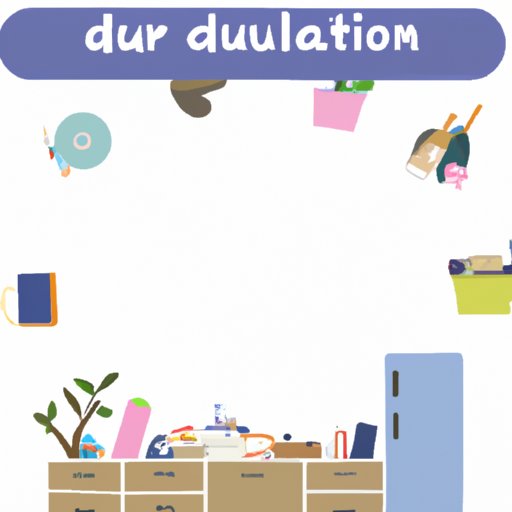Introduction
Decluttering your house can be an overwhelming task. It’s often difficult to know where to start and how to keep the mess from piling up again. However, by taking the time to prioritize what’s important and establish new habits, you can transform your home into an organized and clutter-free space.
But first, let’s define what clutter really is. According to Psychology Today, “Clutter is anything that gets in the way of living the life you want to live.” This means that clutter is not just items that take up physical space but also mental energy, such as unfinished projects or overdue bills. Therefore, when it comes to decluttering, it’s important to consider both physical and mental clutter.
The benefits of decluttering are numerous. A study published in the Personality and Social Psychology Bulletin found that clutter can lead to increased levels of stress and anxiety. Additionally, getting rid of unnecessary items can help you save money and even increase your productivity. So why wait any longer? Let’s get started.
Make a Plan
Before you begin decluttering, it’s important to make a plan of action. Start by setting aside at least one hour a day for decluttering. This will give you enough time to focus on the task at hand without feeling overwhelmed.
Create a checklist of all the areas you want to declutter. If a particular room or area feels too daunting, break it down into smaller sections. For example, if you’re decluttering your bedroom, divide it into categories such as clothes, books, and other miscellaneous items. This will make the task more manageable.
Start Small
Once you have a plan of action, it’s time to start decluttering. Begin with one room or section at a time. Trying to tackle the entire house all at once can be overwhelming and discouraging.
When you start a new section, break it down into smaller chunks. For example, if you’re decluttering your living room, start with one corner at a time. This will help you stay focused and motivated to finish the job.
Sort Items by Category
Now it’s time to start sorting through your items. Create four piles or boxes labeled keep, toss, donate, and sell. As you go through each item, decide which pile it belongs in.
For the keep pile, ask yourself if the item serves a purpose or brings you joy. If so, then it should remain in your home. For the toss pile, ask yourself if the item is broken or no longer useful. If so, then it should be thrown away.
For the donate pile, ask yourself if the item is still in good condition but no longer useful for you. If so, then it should be donated to someone who can use it. For the sell pile, ask yourself if the item still has value and could potentially be sold. If so, then it should be listed online or at a local consignment shop.
Purge Unnecessary Items
Once you’ve sorted your items, it’s time to get rid of the unnecessary ones. Start by identifying all the useless items in your home. These are typically things you don’t use or haven’t used in years, such as old magazines, broken electronics, and unused kitchen gadgets.
Get rid of these items by donating them, throwing them away, or selling them. This will help reduce the amount of clutter in your home and make it easier to organize the remaining items.
Create Storage Solutions
Now that you’ve purged all the unnecessary items, it’s time to create storage solutions for the items you’ve decided to keep. Utilize vertical space by adding shelves and hooks to walls. This will give you more storage without taking up valuable floor space.
Use cabinets and drawers to store items such as clothing, linens, and office supplies. This will help keep your items organized and out of sight. Additionally, use decorative boxes and baskets to store small items such as jewelry and accessories.
Maintain Regular Cleaning
The last step is to establish a regular cleaning routine. This will help you keep your home organized and clutter-free. Set aside at least 15 minutes a day to tidy up. This could include tasks such as putting away clothes, wiping down counters, and dusting shelves.
Additionally, set aside time each week to do a deep clean. This could include tasks such as vacuuming carpets, scrubbing floors, and washing windows. Having a regular cleaning routine will help ensure that your home remains clutter-free.
Conclusion
Decluttering your house doesn’t have to be a daunting task. By establishing a plan of action, breaking it down into smaller sections, and creating storage solutions, you can easily transform your home into an organized and clutter-free space. Additionally, maintaining a regular cleaning routine will help you keep your home organized and clutter-free.
By following these eight steps, you can achieve an organized and stress-free home.
(Note: Is this article not meeting your expectations? Do you have knowledge or insights to share? Unlock new opportunities and expand your reach by joining our authors team. Click Registration to join us and share your expertise with our readers.)
